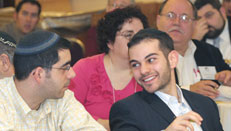 |
||||||||||||
| Weekly Parsha | ||
| Current Week | ||
| Parsha Archives | ||
| Business Ethics | ||
| Dr. Malamet Speaks Out | ||
| TiM MP3 Library | ||




A Thought for the Week with Rabbi Jay Kelman
|
 "How majestic was the kohen gadol as he left the holy of holies in peace without injury"(machzor). This beautiful piyut (liturgical poem) describes the radiance that emanated on Yom Kippur with the tremendous opportunity for renewing our relationship with G-d and by extension our fellow man. "Fortunate is the eye that saw all this". Alas "our forefather's iniquities destroyed the Temple and our sins have delayed the final redemption" (machzor). It is not the Beit Hamikdash itself that is the focus of our mourning but rather the continued sinning of man. The Mishna in yoma which details the extensive temple service of Yom Kippur, ends with Rabbi Akiva, the eternal optimist of the Jewish people, teaching that it is not sacrifices that are the key to atonement but rather blessed are you O Israel,. Before Whom do you cleanse yourself? Who cleanses you? Your Father in heaven (Yoma 8:9). To the generation that had witnessed the destruction of the Temple this was a most crucial and comforting message. Jewish life can and will continue to exist and thrive without a Temple - provided the Jewish people can live in harmony with each other in the service of G-d. Historically those many Jewish sects who focused their Judaism on the Temple could not survive its destruction. Unfortunately the inner sanctity of the Temple had been destroyed much earlier. It was the rare year that the kohen gadol actually "left the holy of holies in peace without injury". Religious corruption infected the leadership of the Temple and subsequently filtered down to the people. It is clear from the mishna that many of the high priests were so ignorant that they did not even understand Hebrew. The high priests would often get appointed through connections or through buying the position outright i.e. bribery. Tragically one never knew if the kohen gadol on any given Yom Kippur could in fact be trusted; many of the kohanim were tzedukim (Sadducees), who did not accept the rabbinic interpretations of the Bible. Thus, after the Sages would warn the kohen gadol to follow the order of the day properly "he would turn aside and weep and they would turn aside and weep" (Yoma 1:5). This desire for kavod and power was so powerful that despite the fact that Yom Kippur service improperly implemented would literally cause the kohen gadol to die, even in the holy of holies, people would vie to be chosen for this most honoured of positions. Our Sages meant it literally when they taught that "jealousy, lust and honour remove a person from this world" (Pirkei Avot 4:25). With corruption rampant in the most holy of places and the Romans tightening their grip on Jerusalem the stage was set for the subsequent breakdown of Jewish communal order and even actual violence between Jews. The machzor continues at great length detailing the terrible repercussions of our infighting and exile. Yet just after the reenactment of the lost Temple service, we recite the piyut eleh ezchara, detailing the death of the asara harugei malchut, the ten Rabbinic giants martyred by the Romans. While on Tisha B'av recalling the tragic deaths are part of the mourning process their recital on Yom Kippur serves a different purpose; that the death of the righteous brings atonement. While this concept may sound Christian to many of us, it is well within our tradition. However, it is not a statement of faith but rather a call to action. The death of the righteous can bring about atonement if it, as it should, leads us to teshuva . By reflecting on the lives of our great leaders we gain inspiration and commit ourselves to the best of our ability, to fill their shoes. The importance of leadership can not be overestimated. It is they who set the tone for any organization and it is the rare organization that can rise above the incompetence, inefficiency or ineffectiveness of its leaders. Judaism literally depends in having the right people leading us. In fact the only time the Torah records Moshe speaking to G-d as opposed to G-d speaking to Moshe is when Moshe pleads for the right leader to be chosen to succeed him. Leaders are in reality a very true reflection of their constituents. May we merit and create the necessary climate so that we can produce those who follow in the footsteps of Rabbi Akiva modeling love for all, total dedication, and hope for a better future. Gmar Chatima Tova. |
|
|

 |
 |